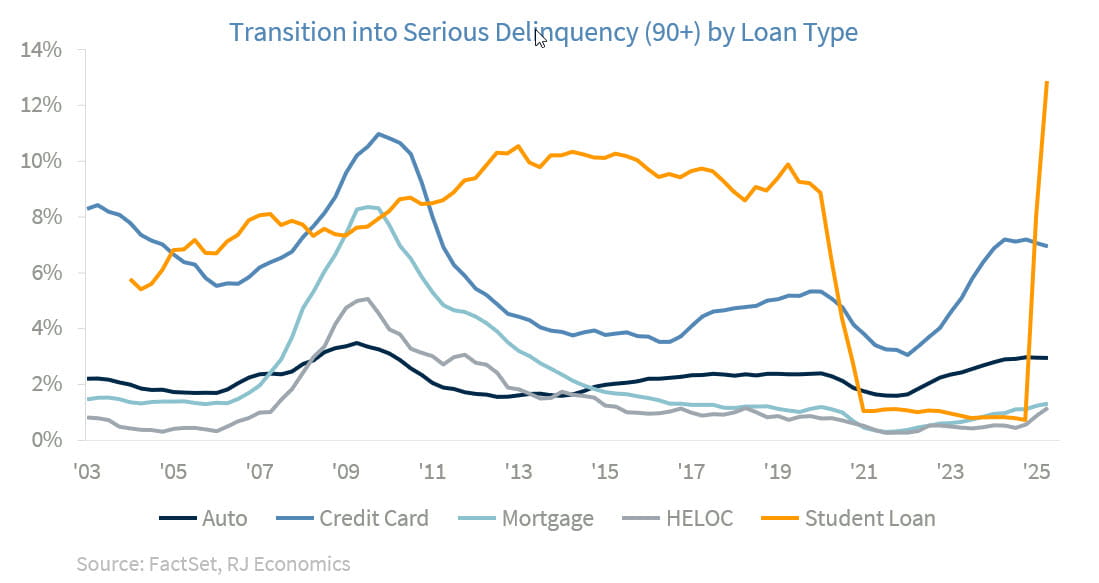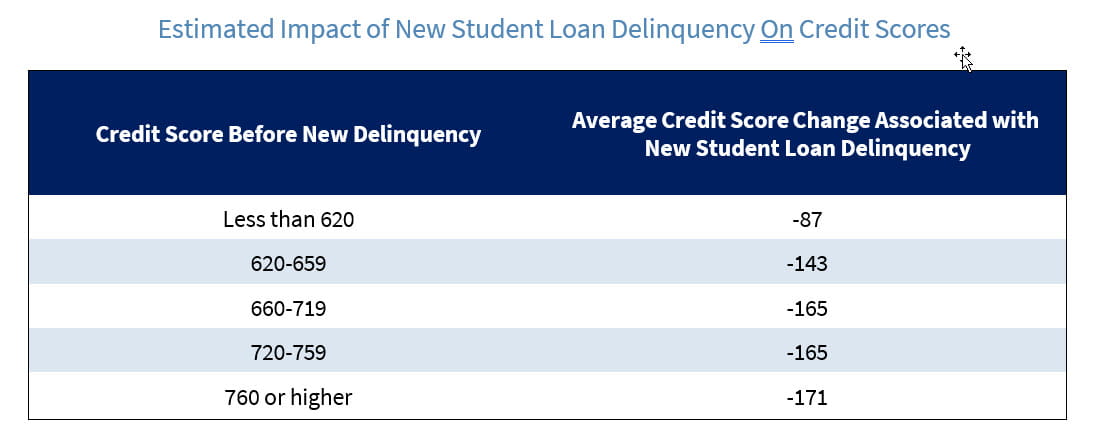Are student loan defaults a concern for the economy?
- 08.15.25
- Economy & Policy
- Commentary
Chief Economist Eugenio J. Alemán discusses current economic conditions.
Over 42 million Americans owe more than $1.6 trillion in student debt, yet only 38% are actively repaying their loans, according to the US Department of Education. The remaining borrowers are in default, delinquency, forbearance, deferment, or grace periods. On the other hand, serious delinquencies, defined as being 90 or more days late, rose to nearly 13% in the second quarter of 2025, the highest level since data collection began in 2004, as shown in the chart below. If this trend continues, nearly a quarter of the federal student loan portfolio could fall into default. Currently, 5.5 million borrowers are already in late delinquency, and that number is expected to grow in the coming quarters.
From an economic standpoint, the immediate impact of missed student loan payments is limited. Since repayments were paused for several years, the government has not been relying on these funds for spending. However, the continued lack of repayment contributes, albeit not meaningfully, to a growing federal deficit, forcing the government to seek alternative fiscal resources. Despite the resumption of payments, the effect on consumer spending is expected to be relatively small. Most borrowers pay around
$200 per month, and if we exclude the 5.5 million borrowers already in default among the 26 million who need to restart payments, about 20 million are expected to restart payments. This would amount to roughly $50 billion in annual payments that could reduce spending in other categories, especially discretionary categories of spending, but only representing a small fraction of the $30 trillion US economy.
Still, the situation is not without consequences. For the 5.5 million borrowers in late delinquency, failure to repay will significantly damage credit scores, reducing access to credit and limiting purchasing power. Discussions around wage garnishment could further reduce disposable income, creating additional headwinds for consumer spending. While credit scores improved during the loan repayment freeze that began in 2020, they are now declining, especially among prime borrowers. Lower credit scores typically lead to smaller credit lines and reduced spending capacity. Although the direct economic impact of student loan defaults may be limited in the short term, the long-term effects, such as weakened credit profiles and reduced consumer activity, could modestly slow overall economic growth.
Source: New York Fed Consumer Credit Panel/Equifax, Liberty Street Economics.
Notes: The table above shows the average change in credit score for borrowers the quarter after they experienced a new delinquency of 90 or more days past due. We limit the sample to borrowers who experienced such an event between 2016:Q1 and 2019:Q4 and isolate to only borrowers’ first such event. Liberty Street Economics then computed the average change in credit score separately by credit score bands in the quarter before the delinquency first appeared on the credit report. Credit scores are Equifax Risk Score 3.0.
This represents just one of several headwinds facing the US economy, alongside potentially higher prices from new tariffs and signs of a softening labor market. Still, these developments support our view that the economy is slowing, not contracting. The foundational elements of US economic resilience, such as consumer strength (especially upper-income households), corporate balance sheets, and labor participation, remain intact. We also anticipate that the Federal Reserve will start lowering rates, which should help offset some of the negative effects of declining credit scores, particularly among lower-income households, by easing borrowing costs and supporting access to credit.
Economic and market conditions are subject to change.
Opinions are those of Investment Strategy and not necessarily those of Raymond James and are subject to change without notice. The information has been obtained from sources considered to be reliable, but we do not guarantee that the foregoing material is accurate or complete. There is no assurance any of the trends mentioned will continue or forecasts will occur. Past performance may not be indicative of future results.
Consumer Price Index is a measure of inflation compiled by the US Bureau of Labor Statistics. Currencies investing is generally considered speculative because of the significant potential for investment loss. Their markets are likely to be volatile and there may be sharp price fluctuations even during periods when prices overall are rising.
Consumer Sentiment is a consumer confidence index published monthly by the University of Michigan. The index is normalized to have a value of 100 in the first quarter of 1966. Each month at least 500 telephone interviews are conducted of a contiguous United States sample.
Personal Consumption Expenditures Price Index (PCE): The PCE is a measure of the prices that people living in the United States, or those buying on their behalf, pay for goods and services. The change in the PCE price index is known for capturing inflation (or deflation) across a wide range of consumer expenses and reflecting changes in consumer behavior.
The Consumer Confidence Index (CCI) is a survey, administered by The Conference Board, that measures how optimistic or pessimistic consumers are regarding their expected financial situation. A value above 100 signals a boost in the consumers’ confidence towards the future economic situation, as a consequence of which they are less prone to save, and more inclined to consume. The opposite applies to values under 100.
Certified Financial Planner Board of Standards Center for Financial Planning, Inc. owns and licenses the certification marks CFP®, CERTIFIED FINANCIAL PLANNER®, and CFP® (with plaque design) in the United States to Certified Financial Planner Board of Standards, Inc., which authorizes individuals who successfully complete the organization’s initial and ongoing certification requirements to use the certification marks.
Links are being provided for information purposes only. Raymond James is not affiliated with and does not endorse, authorize or sponsor any of the listed websites or their respective sponsors. Raymond James is not responsible for the content of any website or the collection or use of information regarding any website's users and/or members.
GDP Price Index: A measure of inflation in the prices of goods and services produced in the United States. The gross domestic product price index includes the prices of U.S. goods and services exported to other countries. The prices that Americans pay for imports aren't part of this index.
Employment cost Index: The Employment Cost Index (ECI) measures the change in the hourly labor cost to employers over time. The ECI uses a fixed “basket” of labor to produce a pure cost change, free from the effects of workers moving between occupations and industries and includes both the cost of wages and salaries and the cost of benefits.
US Dollar Index: The US Dollar Index is an index of the value of the United States dollar relative to a basket of foreign currencies, often referred to as a basket of U.S. trade partners' currencies. The Index goes up when the U.S. dollar gains "strength" when compared to other currencies.
The FHFA HPI is a broad measure of the movement of single-family house prices. The FHFA HPI is a weighted, repeat- sales index, meaning that it measures average price changes in repeat sales or refinancings on the same properties.
Import Price Index: The import price index measure price changes in goods or services purchased from abroad by U.S. residents (imports) and sold to foreign buyers (exports). The indexes are updated once a month by the Bureau of Labor Statistics (BLS) International Price Program (IPP).
ISM Services PMI Index: The Institute of Supply Management (ISM) Non-Manufacturing Purchasing Managers' Index (PMI) (also known as the ISM Services PMI) report on Business, a composite index is calculated as an indicator of the overall economic condition for the non-manufacturing sector.
The ISM Manufacturing Index: The GDP Now Institute of Supply Management (ISM) Manufacturing Measures the health of the manufacturing sector by surveying purchasing managers at manufacturing firms. The survey asks about current business conditions and expectations for the future, including new orders, inventories, employment, and deliveries.
Consumer Price Index (CPI) A consumer price index is a price index, the price of a weighted average market basket of consumer goods and services purchased by households.
Producer Price Index: A producer price index (PPI) is a price index that measures the average changes in prices received by domestic producers for their output.
Industrial production: Industrial production is a measure of output of the industrial sector of the economy. The industrial sector includes manufacturing, mining, and utilities. Although these sectors contribute only a small portion of gross domestic product, they are highly sensitive to interest rates and consumer demand.
The NAHB/Wells Fargo Housing Opportunity Index (HOI) for a given area is defined as the share of homes sold in that area that would have been affordable to a family earning the local median income, based on standard mortgage underwriting criteria.
Conference Board Coincident Economic Index: The Composite Index of Coincident Indicators is an index published by the Conference Board that provides a broad-based measurement of current economic conditions, helping economists, investors, and public policymakers to determine which phase of the business cycle the economy is currently experiencing.
Conference Board Lagging Economic Index: The Composite Index of Lagging Indicators is an index published monthly by the Conference Board, used to confirm and assess the direction of the economy's movements over recent months.
New Export Index: The PMI New export orders index allows us to track international demand for a country's goods and services on a timely, monthly, basis.
Gold is subject to the special risks associated with investing in precious metals, including but not limited to: price may be subject to wide fluctuation; the market is relatively limited; the sources are concentrated in countries that have the potential for instability; and the market is unregulated.
The Conference Board Leading Economic Index: Intended to forecast future economic activity, it is calculated from the values of ten key variables.
Source: FactSet, data as of 7/25/2025




